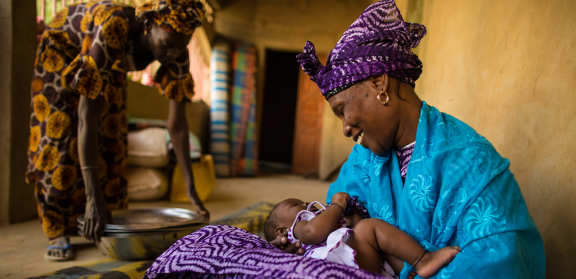
Behavioral science offers nutrition services and programs powerful new tools to accelerate nutrition social and behavior change (SBC). Check out these examples of design innovation applied to nutrition in the Design Innovations Resource Collection. USAID Advancing Nutrition collaborates with Breakthrough ACTION, USAID’s global flagship SBC program, to apply behavioral science innovations to three common nutrition SBC cases, including—
- audience segmentation to help policymakers and programs designers better tailor efforts to improve women’s dietary diversity
- behavioral design to help health workers and families improve young child feeding during and after illness
- human-centered design (HCD) to develop job aids for community health workers to counsel on young child feeding.
Audience Segmentation
Audience segmentation is a key step in program design that aims to tailor services, products, and communication messaging to the specific needs and preferences of subgroups of people. We are testing a survey module in Mozambique that can help programs more effectively promote increased dietary diversity among pregnant and lactating women through audience segmentation. This new how-to guide on audience segmentation helps nutrition programs design, adapt, or tailor program activities.
Behavioral Design
Behavioral design elicits unique insights into people’s mindsets and mental models, such as health providers and other influencers, to better design, test, and implement effective activities. In the Democratic Republic of Congo (DRC), we used a behavioral design approach to conduct formative qualitative research and produce the brief Behavioral Barriers to Feeding Young Children During and After Illness. Health workers and families then tested prototypes of solutions based on the insights to help families set achievable goals for feeding during and after illness, expand their choice set to include additional affordable and nutritious local foods, build skills and confidence to overcome limited appetite, and celebrate each bite as a small victory. This design brief Behavioral Solutions for Child Feeding During and After Illness provides a summary of the process and solutions.
We encourage practitioners to use or adapt the prototypes developed through this process when programs have similar objectives and face similar challenges. Or, use the behavioral design approach for other nutrition challenges that would benefit from a deeper understanding of mindsets and mental models around decision-making.
In April 2022, we hosted a webinar about the design, the prototypes refined and dropped from the solution set, and ideas for application. Review the event materials to learn more.
Human-Centered Design
A Human-Centered Design (HCD) approach focuses on user’s needs, and collaboratively generates solutions with users to a specific challenge. In Kebbi State, Nigeria, we used an HCD approach to develop counseling aids for Community Health Workers (CHWs) on young child feeding. The job aid guides CHWs to create a caring experience for caregivers through “Empathways to Nutrition” with personal questions that both the counselor and client answer, learning from lessons in reproductive health and nutrition.
We are working to translate the learnings from these applications into a user-friendly kit specifically for nutrition program planners and implementers who are interested in using behavioral science to design or adapt their approaches. Are you interested in using behavioral design or HCD to accelerate impact? This new guide helps programs decide on an approach and follow the steps using experiences in nutrition. Learn more about USAID Advancing Nutrition’s global SBC work.